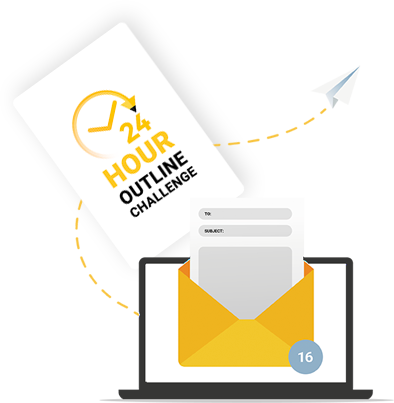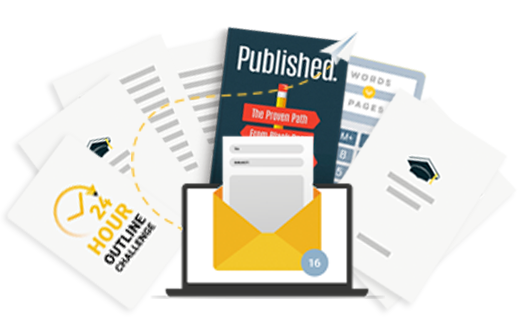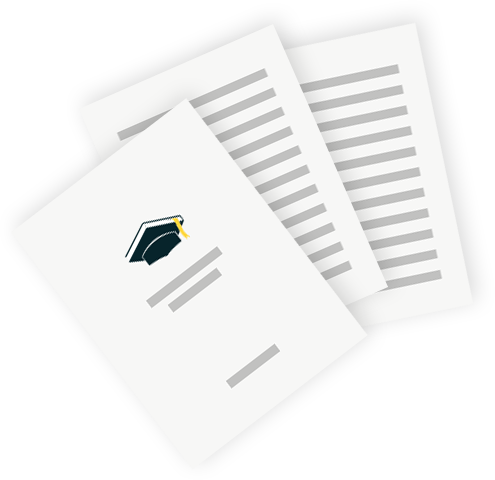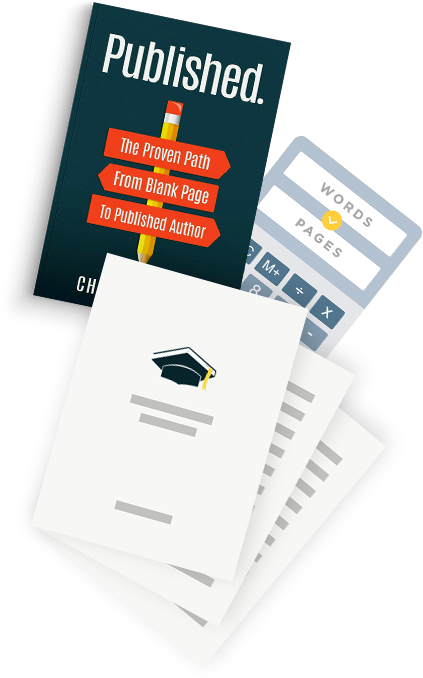There’s a specific way you should learn how to write a nonfiction book if you want it to do well.
Whether you’re looking to write and publish a book to grow your business or if you just want to write a book to make an impact, doing it well the first time makes a major difference.
Imagine throwing a book together with no rhyme or reason…and then wondering why it isn’t selling. That won’t be your reality if you follow this system.
Here’s how to write a nonfiction book:
- Come up with your nonfiction book idea
- Do some market research
- Nail down your book’s target audience
- Mindmap and outline your nonfiction book
- Schedule book writing time
- Write a strong book introduction
- Write your nonfiction book in order
- Write your first draft straight through
- Do book research
- Self-edit your book
- Choose a nonfiction book title
- Send to betas for feedback
- Go through the production process or query agents
What is a Nonfiction Book?
A Nonfiction book is a piece of written document that is focused on facts. It’s opposed to fictional stories such as Harry Potter or Chronicles of Narnia.
It can be a memoir, a captivating biography, an instructional book on how to make a coffee table, a self-help book, or even a travel guide to Chile. As long as the content is real and none of it is made up, it can be considered a nonfiction book.
Writing a Nonfiction Book for Beginners: Quick Tips
The biggest reason most people don’t write a book is because they think they’re not a good writer. But as a C- English student who used to hate writing… Trust me, you can do it.
Even though I didn’t have the best English skills, I still wrote and published 6 bestselling books. That’s why I started Self-Publishing School and our Become a Bestseller program to begin with.
I figured out how to write a high-quality book despite writing skills, and that’s what I want you to know: you don’t need to be a good writer to produce a good book.
All you need is an idea…and we here at Self-Publishing School believe that everyone has a book in them. We just specialize in getting it out and published to its best form.
But in addition to that, I wanted to drop some other tips for beginners, those looking to start writing a book for the first time:
- Don’t compare yourself
- Don’t try to copy or recreate a popular book
- Write about what you know, have experienced, and what people ask you about often
- Be honest with yourself (and therefore, the readers)
- Look to those with experience to go through this process correctly (think of: How vs Who…you always want to look for the Who to solve things)
- Get some support from friends or family (our students usually make an accountability buddy in our exclusive Mastermind Community)
- Commit to it, that’s one of the hardest parts
Ultimately, it’s a learning curve, but that’s why we have this content available on the blog, plus my free book writing and publishing training.
Nonfiction Book Writing Template
We actually have a book outline template generator created by one of our coaches who has written and published 30 books.
That’s right, she has a ton of experience and knows what she’s doing.
You can fill out the generator at the top of this post and the template will be emailed to you right away. You will have to go do File > Make a copy in order to save this template for yourself, otherwise you can’t edit it since this is used for everyone needing a template.
How to Write a Nonfiction Book in 13 Quality Steps
We’re finally to the great stuff! Let’s go through how to write a nonfiction book step by step.
I’ve been through this several times and am breaking it down to the essential steps only. Save some time and stick to these basic principles of writing a nonfiction book.
#1 – Choose your nonfiction book idea
If you’re here, you likely have a book idea… Or maybe a few. This can be really difficult if you have more than one idea ready to go that you think is important.
Here’s what we tell our students in terms of choosing which book idea to tackle first:
- Write the one that will be the easiest for you
- Write the one that you can finish the quickest
It’s really that easy. That’s the best way to choose a book idea to go with if you’ve got too many or aren’t sure which should be done first.
But if you need to generate ideas, here are a few tips to come up with a book idea:
- Use some writing prompts or check out this post on things to write about
- Sit down with a sheet of paper and jot down subjects you consider yourself an authority on (you know a ton of accurate information)
- Write down a few things people often ask you questions about (I originally wrote The Productive Person because many people wanted to know how I got so much done)
- Think about the topics that make you talk a bunch during get-togethers/gatherings
- What are you crazy passionate about?
This is a great start and you’ll likely even have a few ideas pop up as you read this. Make sure to write them down and choose the one that falls into the above two criteria I mentioned.
#2 – Do market research
One thing we do a little differently here at Self-Publishing School is teach our students how to ensure your book is hot in the market. While this isn’t necessarily “writing to market”, it does ensure you’ll bring in some income from it.
If you’re not worried about that, then this isn’t necessarily something you need to do, but we still recommend it to understand what books in your genre are doing as far as the cover, title, etc.
Here’s my process for market research for the book idea/s I’m planning to write:
- Go on Amazon
- Choose “Books” from the search dropdown departments
- Search for something in the range of what you want to write, keywords help (publishing, paleo recipes, mental health self-help, etc.)
- Take note and even save some titles/topics that are close to what you want to do
- To go deeper, click on a book that is close to what you want to write about
- Scroll down to the “Product Details” section view the categories they’re ranking in under “Amazon Best Sellers Rank”
Repeat that exercise with various categories related to your idea.
The reason we do this is to see what’s working so you can build off of an already stable foundation.
Additionally, if you want to know more about Amazon Categories, check out Dave Chesson’s PublisherRocket service.
#3 – Nail down your target audience
This is one of the most crucial steps for your book’s longevity. The more you can create a clear picture of who your avatar is, the better your book will perform and the better Amazon reviews you’ll get.
This is something that’s really special about our programs. Every one of them has 1-on-1 coaching with a highly experienced bestseller, and they go through a big deep dive on your target audience, before you even start your outline with us.
Ultimately, you want to get to the point where, when you’re writing your book, you’re speaking to one person: your ideal audience member.
This helps the book be concise, highly targetted so it will be received better by people who need it, and those who do read it will review it highly because it’s made for them.
But how do you nail down your target audience details when writing a nonfiction book?
Steps for building a book’s target audience:
- How old are they?
- What do they do for fun?
- What’s their financial status?
- Are they aware of their problem?
- What have they done already to try to solve the problem that didn’t work?
- Where have they been looking for help with this problem?
- What type of style do they have?
- What’s their vocabulary like?
- What will their name be for your own reference?
These questions can help you get started so you know exactly who you’re writing for, what type of writing/style they respond to, and what problems and objections you’ll have to face when writing your nonfiction book.
#4 – Mindmap and outline your nonfiction book
Mindmap first, then outline.
That’s the system we follow and it’s by far the best because when your mindmap is complete, you can just pull over each topic into an orderly outline like one you (hopefully) downloaded earlier.
You can learn how to mindmap a book right here, and download your free printable mindmap here.
When it comes to this tactic, you have to sit down with no distractions and jot down everything and anything you can think of in your mindmap. Go nuts! This is not the time for thoughts like, “is this necessary here?” No.
The idea is to get out every piece of knowledge you have on the main topic that’s in the middle of your mindmap.
Then when that’s done, move on to filling out your outline in order of what topics you think should go in what order. Once your book outline is done, it’s (mostly) smooth sailing from there.
#5 – Schedule time to write your book
If you don’t put it on the calendar somewhere, it probably won’t get done.
Writing a nonfiction book isn’t something you can just shrug at and say, “I’ll get to it when I get to it,” because you and I both know there are a million things that could get in the way of that—like watching Tiger King on Netflix.
But if you give it space in your calendar, you’re announcing to you and everyone else that it’s a priority, it’s something you’re committed to.
Check out this great video about building a writing habit if you want to get this down better:
#6 – Write a strong book introduction
We actually have a blog post completely dedicated to this topic you can check out here: how to write an introduction for a book.
But we’ll also go over the main details here as well, so you can get started right away. You can also download our book outline template if you haven’t already, which has an introduction detailed and outlined (developed by one of our coaches who has 30 self-published books).
Really what you’re doing with a book introduction is selling your book. It’s more in line with copywriting than anything else. Copywriting meaning salesmanship in writing.
Which is what you need your introduction to be. Otherwise, why would they buy the book? Why else would they read the whole thing?
Now onto your introduction…
- Identify the problem you’re going to solve
- Present the solution you have to that problem
- Reassert your credibility and why you can solve this
- Show them the benefits of solving this issue
- Give your reader proof as to how and why this works
- Give them a huge promise, a major, bold promise
- Warn them against waiting to start/reading
- Prompt them to start the first chapter (if someone’s only peeking at the Amazon “Look Inside” this can prompt them to buy!)
Check out this video I filmed for y’all for more details:
#7 – Write your nonfiction book in order
Once you know the order you’ll keep your book in from the outline, write it exactly in that order. This is really important because there needs to be a sense of progression and cohesiveness overall.
If your book reads like it skips around, people will be put off by the lack of consistency in the style.
That’s why we always recommend writing it in order and not just writing whatever you want first. Trust us on this one.
It seems simple but being able to mention previous parts of the book for reference is super important for refreshing a reader’s memory and pulling them back into that same frame of mind.
#8 – Write the first draft straight through
This means no stopping to research or edit. Nope. We write our drafts completely through because this is the fastest way to make sure your draft gets done.
What we’ve found that the biggest obstacle between someone who has a book idea and someone who becomes an author is finishing that first draft.
Too many writers get caught up in making the first draft perfect and when it’s not (because it’s a first draft) they throw in the towel. Don’t be that person.
Don’t be someone who just wanted to write a book…be the person who did, and then published it successfully.
If you have places where you need to do some factual research, put the letters TK in place of data you need, and move on. You can later do a Command/Ctrl+F in order to search each of these places and provide the right information.
This video has some additional hacks for finishing your book faster, so it actually gets done at all:
#9 – Do nonfiction book research
After you completed your draft and put that TK in place of research, do a Command/Ctrl+F and search those letters.
You’ll find all the areas of research you need to complete and you can go through in order, same as you did when writing. This is the best way to do research because you’ll only spend time finding exactly what you need to find instead of spending hours digging through information for stuff to “pull” into your book.
Research should be used to confirm and validate your own experiences, not as a starting point for you to start writing. It comes off as much more authentic and authoritative this way.
#10 – Self-edit your book
You’ll both love and hate this part. Going back over your first draft can be a little emotionally troubling because you’ll want it to be perfect the first time.
It can feel like a setback but this is why we self-edit!
First, you got out what you needed to. Now, you chisel away the excess, sharpen the message, and drill your solution home. This is the part where you make everything merge together.
We have a full blog post on how to self-edit your book you can read to learn more about the process and what specifically you should be looking for.
#11 – Choose a nonfiction book title
You might be wondering why this is so far down on the list. Most people come up with the title before they even write…don’t they?
If they do, it’s likely not a fitting title. When students go through our Become a Bestseller program, they’re most shocked by this because our coaches instruct them to not title their book until they’re finished and have edited it.
The main reason for this is because so much can change from your idea to your outline to the finished product itself. So instead of trying to fit your book to a title that just might not work, write the book and then craft a compelling title that will actually encompass and sell the book’s content.
Here are our overall tips for choosing a book title:
- Make your title searchable
- Make it clear and concise: your reader should know exactly what they’re getting
- Write 5-10 main titles and then narrow it down to your favorite 5
- Push those out for feedback in writing groups or to your friends/family. Our students often post polls for feedback in our exclusive Mastermind Community for upwards of 25 responses.
- Craft your subtitle only after you have the main title
- Make sure this goes deeper into what content your book will cover, using keywords people search is also highly encouraged
- Here’s an example of what a strong title would be – The Mental Health Mindshift: How to Take Control of Your Mental Health, Manage it Easily, & Shift Your Point of View
Do you have any special tactics for coming up with great titles? Drop a comment below with your own process!
Here’s another great video overview of the process with more tips:
#12 – Send to betas for feedback (optional)
Not all books need this and it’s certainly more important for fiction than a nonfiction book. However, if you have a few weeks to spare, it can help uplevel your book significantly.
What you really want here is a group of people who fit your target audience who can read through your book and answer questions and give feedback about it.
These people are known as beta readers. They read your book before the professional edit and give you feedback as someone reading it for the first time.
This helps you see your book through the eyes of a “fresh” reader because as much as we wish we could, we just can’t read our book as if we’ve never seen its contents before.
Making sure it all makes sense, is clear, and there isn’t any confusion goes a long way to producing a high-quality book.
#13 – Go through the production process or query agents
I won’t detail the process from editing to cover design to formatting for those of you looking to self-publish a book, since this is mainly about how to write the book.
But here are our best resources covering the production process:
- How to self-edit a book
- How to hire a book editor
- How to work with a book editor effectively
- All about book cover design
- What makes a good book cover
- How to format a book
- How to make an audiobook (if that’s your next direction)
- What makes for a good audiobook
If you’re self-publishing, you’ll have to go through all of these yourself before publishing.
If you’re someone who wants to go the traditional route, you’d bypass this stage, write a book blurb and synopsis, and then query agents until you land one (this could take months to years).
Don’t forget your free outline!



